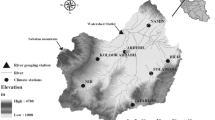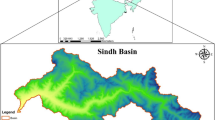Abstract
This paper presents the application of a long-term streamflow forecasting model developed using artificial neural networks at a stream gauging station in the Awash River Basin, Ethiopia. The gauging station is located above the headworks of a large irrigation scheme called the Middle Awash Agricultural Development Enterprise (MAADE). Based on the forecasted streamflow time series and water requirements for irrigation and environmental purposes, appropriate agricultural water management strategies have been proposed for the irrigation scheme (MAADE). The water management strategies which were evaluated in this study are based on different scenarios of abstraction demands. These demands were formulated based on a range of options for agricultural development and change in MAADE. The scenarios evaluated were based on such factors as the existing planting patterns, changing planting dates, changing crop varieties and reducing the area under cultivation. An appropriate scenario of agricultural development was decided on the basis of the modified flows in the river vis-à-vis the trigger/threshold value established at the Melka Sedi stream gauging station. Considering all the scenarios, it is suggested that a 1–24% reduction in the area currently irrigated in the scheme will ensure a reliable supply of water to the scheme throughout the growing season and will provide sustainable environmental flow in the river.
Similar content being viewed by others
References
Altunkaynak A (2007) Forecasting surface water level fluctuations of lake van by artificial neural networks. Water Resour Manage 21:399–408
Brouwer C, Hoevenaars JPM, van Bosch BE, Hatcho N, Heibloem M (1992) Irrigation water management: training manual No. 6—scheme irrigation water needs and supply. FAO, Rome, Italy
Carson DJ (1998) Seasonal forecasting. J R Meteorol Soc 124:1–26
Chen C-S, Chou FN-F, Chen BP-T (2010) Spatial information-based back-propagation neural network modeling for outflow estimation of ungauged catchment. Water Resour Manage. doi:10.1007/s11269-010-9652-6
Danon Y (1997) Scientific software. URL address http://www.nuceng.com/WinNN.htm. Access date: 15/01/2004
Desalegn CE, Babel MS, Gupta AD, Seleshi BA, Merrey D (2006) Farmers’ perception of water management under drought conditions in the Upper Awash Basin, Ethiopia. Int J Water Resour Dev 22(4):589–602
Desalegn CE, Babel MS, Gupta AD (2010) Drought analysis in the Awash River Basin, Ethiopia. Water Resour Manage 24(7):1441–1460
Dong H, Li W, Tang W, Li Z, Zhang D, Niu Y (2006) Yield, quality and leaf senescence of cotton grown at varying planting dates and plant densities in the Yellow River Valley of China. Field Crops Res 98(2–3):106–115
Doorenbos J, Pruitt WO (1977) Crop water requirements. FAO Irrigation and Drainage Paper No. 24, Rome, Italy
Dracup JA, Lee KS, Paulson EG Jr (1980) On the definition of droughts. Water Resour Res 16(2):297–302
El-Shafie A, Abdin AE, Noureldin A, Taha MR (2009) Enhancing inflow forecasting model at Aswan high dam utilizing radial basis neural network and upstream monitoring stations measurements. Water Resour Manage 23:2289–2315
English M (1990) Deficit irrigation. I: analytical framework. J Irrig Drain Eng 116(3):399–412
English M, Nuss GS (1982) Designing for deficit irrigation. J Irrig Drain Eng 108(2):91–106
English M, James L, Chen C (1990) Deficit irrigation. II: observations in Columbia basin. J Irrig Drain Eng 116(3):413–427
Ethiopian Valleys Development Studies Authority (1979) Amibara irrigation project II: inception report for technical support services. Halcrow-ULG Ltd
European Environment Agency (2001) Sustainable water use in Europe, Part 3: Extreme Hydrological Events: Floods and Droughts. Environmental Issue Report No. 21, 84pp
Goddard L, Mason SJ, Zebiak SE, Ropelewski CF, Basher R, Cane MA (2001) Current approaches to seasonal-to-interannual climate predictions. Int J Climatol 21:1111–1152
Gopakumar R, Takara K, James EJ (2007) Hydrologic data exploration and river flow forecasting of a humid tropical river basin using artificial neural networks. Water Resour Manage 21:1915–1940
Gorantiwar SG, Smout IK (2003) Allocation of scarce water resources using deficit irrigation in rotational systems. J Irrig Drain Eng 129(3):155–163
Hargreaves GH, Samani ZA (1984) Economic considerations of deficit irrigation. J Irrig Drain Eng 110(4):343–358
Howell T (1990) Relationship between crop production and transpiration, evaporation and irrigatio. In: Steward BA, Neilson DR (eds) Irrigation of agricultural crops, agronomy monograph No. 30 ASA, CSSA and SSSA, Madison, WI, pp 391–434
Jain A, Kumar AM (2007) Hybrid neural network models for hydrologic time series forecasting. Appl Soft Comput 7(2):585–592
Keller J, Sivanappan RK, Varadan KM (1992) Design logic for deficit drip irrigation of coconut tree. Irrig Drain Syst 6:1–7
Lee KT, Hung W-C, Meng C-C (2008) Deterministic insight into ANN model performance for storm runoff simulation. Water Resour Manage 22:67–82
Lyle WM, Bordovsky JP (1995) LEPA corn with limited water supplies. Trans ASAE 38:2455–2462
Mohanty S, Jha MK, Kumar A, Sudheer KP (2009) Artificial neural network modeling for groundwater level forecasting in a River Island of Eastern India. Water Resour Manage. doi:10.1007/s11269-009-9527-x
Nagesh Kumar D, Raju KS, Sathish T (2004) River flow forecasting using recurrent neural networks. Water Resour Manage 18:143–161
Nayak PC, Rao YRS, Sudheer KP (2006) Groundwater level forecasting in a shallow aquifer using artificial neural network approach. Water Resour Manage 20:77–90
Nourani V, Komasi M, Mano A (2009) A multivariate ANN-wavelet approach for rainfall-runoff modeling. Water Resour Manage 23:2877–2894
Ochoa-Rivera JC, Garcia-Bartual R, Andreu J (2002) Multivariate synthetic streamflow generation using a hybrid model based on artificial neural networks. J Hydrol Earth Sci 6:641–654
Oktem A, Simsek M, Oktem AG (2003) Deficit irrigation effects on sweet corn (Zea mays saccharata Sturt) with drip irrigation system in a semi-arid region. I: water–yield relationship. Agric Water Manag 61:63–74
Pandey RK, Marancilla JW, Chetima MM (2000) Deficit irrigation and nitrogen effects on maize in a Sahelian environment. Part II. Shoot-growth, nitrogen uptake and water extraction. Agric Water Manag 46:15–27
Pulido-Calvo I, Portela MM (2007) Application of neural approaches to one-step daily flow forecasting in Portuguese watersheds. J Hydrol 332(1):1–15
Richard GA, Pereira LS, Raes D, Smith M (1998) Crop evapotranspiration-guidelines for computing crop water requirements. FAO Irrigation and drainage paper No. 56, Rome, Italy
Rodrigues P, Machado T, Pereira L, Teixeira J, El Amami H, Zairi A (2003) Feasibility of deficit irrigation with center-pivot to cope limited water supplies in Alentejo, Portugal. In: Rossi G, Cancelliere A, Pereira L, Oweis T, Shatanawi M, Zairi A (eds) Tools for drought mitigation in Mediterranean regions. Kluwer, The Netherlands, pp 203–222
Smith M, Clarke D, El-Askari K (1998) CropWat 4 Windows Version 4.3. FAO, IIDS and NWRC
Sohail A, Watanabe K, Takeuchi S (2008) Runoff analysis for a small watershed of Tono area Japan by back propagation artificial neural network with seasonal data. Water Resour Manage 22:1–22
Sudar RA, Saxton KE, Spomer RG (1981) A predictive model of water stress in corn and soybeans. Trans ASAE 24(1):97–102
Vaux HJ, Pruit WO (1983) Crop–water production functions. In: Hillel D (ed) Advances in irrigation, vol 2. Academic, New York, pp 61–97
Vogt JV, Somma F (eds) (2000) Drought and drought mitigation in Europe. Kluwer Academic Publishers, The Netherlands, p 325
Wilhite DA, Dinar A (1985) Understanding the drought phenomenon: the role of definitions. Water Int 10(3):111–120
Zhang H, Oweis T (1999) Water–yield relations and optimal irrigation scheduling of wheat in the Mediterranean region. Agric Water Manag 38:195–211
Author information
Authors and Affiliations
Corresponding author
Rights and permissions
About this article
Cite this article
Edossa, D.C., Babel, M.S. Application of ANN-Based Streamflow Forecasting Model for Agricultural Water Management in the Awash River Basin, Ethiopia. Water Resour Manage 25, 1759–1773 (2011). https://doi.org/10.1007/s11269-010-9773-y
Received:
Accepted:
Published:
Issue Date:
DOI: https://doi.org/10.1007/s11269-010-9773-y




